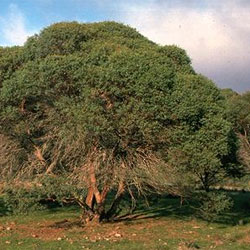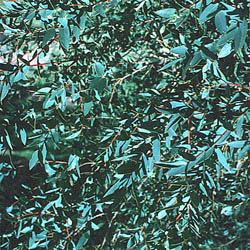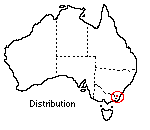Eucalyptus parvula
 |
 |
Small-leaved gum
Eucalyptus parvula L.A.S.Johnson & K.D.Hill
This small-leafed tree is one of the most compact of the eucalypt species, having a rounded shape with branches close to the ground. E. parvula is an ideal specimen tree for small gardens. It is also useful in groups for wind protection or in hedge-type rows for privacy. It is an excellent tree for cold damp positions.
 In
its natural habitat E. parvula is restricted to the high country of south-eastern
New South Wales. A fine stand can be seen at the head waters of the Tuross River,
north-east of Kybean towards Nimmitabel. E. parvula grows in the valleys
where the soil is poorly drained and where conditions are cold, with frost,
snow and heavy mist.
In
its natural habitat E. parvula is restricted to the high country of south-eastern
New South Wales. A fine stand can be seen at the head waters of the Tuross River,
north-east of Kybean towards Nimmitabel. E. parvula grows in the valleys
where the soil is poorly drained and where conditions are cold, with frost,
snow and heavy mist.
In its natural state it can grow to 10 m in height and may be greater in width. The trunk, which may be single or divided, sheds its bark in thin strips, leaving a smooth dark-grey surface with a 100 mm collar of hard deeply ridged bark at the base.
A distinctive feature of this species is that mature trees retain their juvenile leaves, which are opposite and approximately 25 mm long. Several specimens have been growing in the Australian National Botanic Gardens since 1971. Flowering occurs from January to March in the wild and the fruit stays tightly packed along the stems.
Propagation is by seed, which at a temperature of 25ºC takes 5-10 days to germinate. The seedlings should be pricked out into large containers as soon as they can be handled, and when strong enough planted out into a permanent position in spring.
Because of their ability to grow in waterlogged areas, E. parvula should be watered well in summer to maintain optimum condition.
Eucalyptus parvula seems to be much freer from pests and diseases than many other eucalypts. It does not appear to suffer significantly from leaf-eating beetles and although some scale has been observed, it may be controlled by use of low-toxicity products. Consult local specialists for recommendations.
Text by Nora Ollerenshaw, ANBG (1983)
Name meaning: Eucalyptus parvulaEucalyptus - from the Greek, eu, meaning well, and kalyptos, meaning covered, alluding to the cap or lid which covers the stamens in bud; parvula - from the Latin, parvus, meaning little. |
![An Australian Government Initiative [logo]](/images/austgovt_brown_90px.gif)

